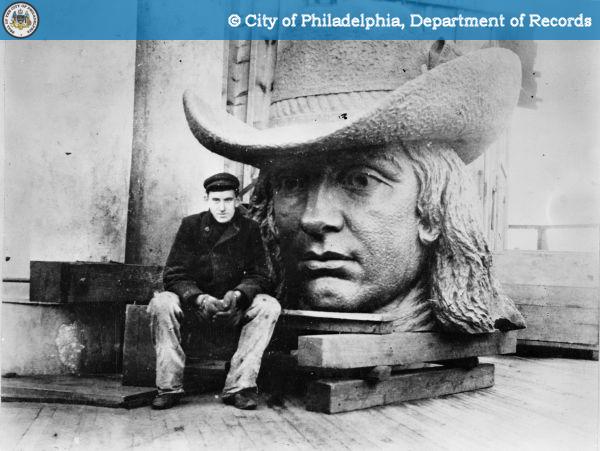
William Penn's head, sculpted by Alexander Calder, cast by Tacony Iron Works, awaits being hoisted atop City Hall.
Tacony Iron Works, 1881-1910
Dodge Steel, 1919
6500 State Road, Philadelphia PA 19135
(between Elbridge Street and Magee Avenue, east to Delaware River)
© Harry C. Silcox, Ed.D.,
Workshop of the World (Oliver Evans Press,
1990).
One of the earliest companies
that moved into Tacony to take advantage of the location
and reputation of the workers in the community was the
Tacony Iron Works. Opened early in 1881 on land directly
south of the Disston plant on State Road, the iron works
produced the structural iron work for the tower and the
giant statue of William Penn for the Philadelphia City
Hall. Tacony residents watched the progress of Alexander
Milne Calder's statue of Penn with great pride and
delight. The statue, consisting of 47 pieces, was moved
from the Tacony Iron Company to City Hall Square by Levi
Eldridge's dray, a special sled for carrying heavy loads;
the team of horses was driven by Nick Tomlinson.
The Tacony Iron Works was abandoned in 1910 and in 1914
the Lubin Film Studio at 8th and Market Streets selected
the site to stage a fire for one of its films, "Gods of
Fate." The factory was set on fire so that a scene could
be filmed with the actors escaping from a window.
Unfortunately, the fire spread and the building burned to
the ground. 1
In 1919 Kern Dodge founded Dodge Steel and moved the firm
onto the grounds of the Tacony Iron Works. One of Dodge
Steel's most outstanding and important developments was
the Williams Method—a process that made possible
the successful and economical manufacture of castings.
The man who invented the method was John A. Williams,
foreman of the molding department of Dodge Steel Company
during 1937-38. Charles Tolan, Jr. was president during
those years and he kept the process a secret. Valve
bodies, pump and turbine parts, and castings for the
railroad, marine, and automobile industries bearing the
‘DS’ trademark were considered among the best
in the world. Dodge Steel's main building is still
standing. 2
1 "When
1914 'Fire' Became Real: Did Hollywood-on-Schuylkill
Die," Bulletin Collection, Tacony
Iron Works Steel Envelope, (April 30, 1967), Urban
Archives, Paley Library, Temple University; see
also, "Aluminum
Electro-plating in Architecture,"
Scientific
American, (New York, October 22, 1892), p. 261.
2 "Tacony,
1906," (Tacony Iron Company); see
also "They
Know Casting," Bulletin Collection, Dodge
Steel Envelope, (November 1952), Urban Archives, Paley
Library, Temple University.
Update May
2007 (by
Torben Jenk):
Demolished. Six hundred fifty new homes are proposed for
this eighteen-acre site.